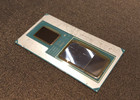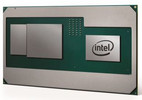Intel Core i7-8709G vs Intel Core i7-8705G vs Intel Core i7-8809G
Intel Core i7-8709G
► remove from comparison
The Intel Core i7-8709G is a fast quad-core processor for notebooks based on the Kaby Lake architecture and was announced in January 2018. similar to the Core i7-7920HQ it integrates four processor cores clocked at 3.1 - 4.1 GHz. As a speciality the package also contains a Vega based graphics card from AMD (with 24 CUs = 1536 shaders at 1190 MHz) and 4 GB HBM2 graphics memory. The CPU is still produced in 14nm as the i7-7920HQ.
Architecture
Intel basically uses the same micro architecture compared to Skylake, so the per-MHz performance does not differ. The manufacturer only reworked the Speed Shift technology for faster dynamic adjustments of voltages and clocks, and the improved 14nm process allows much higher frequencies combined with better efficiency than before.
Performance
Compared to the i7-7920HQ, the i7-8809G should be slightly faster due to the HBM2 memory and the 100 Watt TDP. The performance is therefore sufficient even for very demanding tasks and on par with powerful desktop quad-core processors.
Graphics
In addition to the Intel HD Graphics 630 in the CPU die, the Core i7-8809G also offers an AMD Radeon RX Vega M GH graphics card with 24 Cus and therefore more than double the amount of the current Ryzen APUs (e.g. Ryzen 7 2700 with 10 CUs).
Contrary to Skylake, Kaby Lake now supports hardware decoding for H.265/HEVC Main 10 with a 10-bit color depth as well as Google's VP9 codec. The 8809G should also support HDCP 2.2, but for HDMI 2.0, it most likely needs a converter from DisplayPort.
Power Consumption
The CPU chip is manufactured in an improved 14nm process with FinFET transistors. It is rated at a TDP of around 100 Watt and therefore is only suited for laptops with good cooling solutions. Compared to laptops with Core i7-H quad cores and dedicated graphics cards, the i7-8709G based models can be built with smaller chassis.
Intel Core i7-8705G
► remove from comparison
The Intel Core i7-8705G is a fast quad-core processor for notebooks based on the Kaby Lake architecture and was announced in January 2018. similar to the Core i7-7920HQ it integrates four processor cores clocked at 3.1 - 4.1 GHz. As a speciality the package also contains a Vega based graphics card from AMD (rumors speak of 20 CUs = 1,280 shaders at 1011 MHz) and 4 GB HBM2 graphics memory. The CPU is still produced in 14nm as the i7-7920HQ. Similar to the Core i7-8706G, but without vPro support. Compared to the high-end Kaby Lake-G models, the i7-8705G only features 20 instead of 24 CUs for the Vega GPU and a lower TDP of 65 versus 100 Watt.
Architecture
Intel basically uses the same micro architecture compared to Skylake, so the per-MHz performance does not differ. The manufacturer only reworked the Speed Shift technology for faster dynamic adjustments of voltages and clocks, and the improved 14nm process allows much higher frequencies combined with better efficiency than before.
Performance
Compared to the i7-7920HQ, the i7-8705G should be slightly faster due to the HBM2 memory and the 65 Watt TDP. The performance is therefore sufficient even for very demanding tasks and on par with powerful desktop quad-core processors.
Graphics
In addition to the Intel HD Graphics 630 in the CPU die, the Core i7-8809G also offers an AMD Radeon RX Vega M GL graphics card with 20 CUs and therefore double the amount of the current mobile Ryzen APUs (e.g. Ryzen 7 2700 with 10 CUs) but 4 less than the Vega M GH of the high end models.
Contrary to Skylake, Kaby Lake now supports hardware decoding for H.265/HEVC Main 10 with a 10-bit color depth as well as Google's VP9 codec. The 8809G should also support HDCP 2.2, but for HDMI 2.0, it most likely needs a converter from DisplayPort.
Power Consumption
The CPU chip is manufactured in an improved 14nm process with FinFET transistors. It is rated at a TDP of around 65 Watt and therefore is only suited for laptops with good cooling solutions. Compared to laptops with Core i7-H quad cores and dedicated graphics cards, the i7-8705G based models can be built with smaller chassis.
Intel Core i7-8809G
► remove from comparison
The Intel Core i7-8809G is a fast quad-core processor for notebooks based on the Kaby Lake architecture and was announced in January 2018. similar to the Intel Xeon E3-1535M v6 it integrates four processor cores clocked at 3.1 - 4.2 GHz. As a speciality the package also contains a Vega based graphics card from AMD (with 24 CUs = 1536 shaders at 1190 MHz) and 4 GB HBM2 graphics memory. The CPU is still produced in 14nm as the i7-7920HQ.
Architecture
Intel basically uses the same micro architecture compared to Skylake, so the per-MHz performance does not differ. The manufacturer only reworked the Speed Shift technology for faster dynamic adjustments of voltages and clocks, and the improved 14nm process allows much higher frequencies combined with better efficiency than before.
Performance
Compared to the i7-7920HQ, the i7-8809G should be slightly faster due to the HBM2 memory, 100 MHz higher Boost clock and the 100 Watt TDP. The performance is therefore sufficient even for very demanding tasks and on par with powerful desktop quad-core processors.
Graphics
In addition to the Intel HD Graphics 630 in the CPU die, the Core i7-8809G also offers an AMD Radeon RX Vega M GH graphics card with 24 Cus and therefore more than double the amount of the current Ryzen APUs (e.g. Ryzen 7 2700 with 10 CUs).
Contrary to Skylake, Kaby Lake now supports hardware decoding for H.265/HEVC Main 10 with a 10-bit color depth as well as Google's VP9 codec. The 8809G should also support HDCP 2.2, but for HDMI 2.0, it most likely needs a converter from DisplayPort.
Power Consumption
The CPU chip is manufactured in an improved 14nm process with FinFET transistors. It is rated at a TDP of around 100 Watt and therefore is only suited for laptops with good cooling solutions. Compared to laptops with Core i7-H quad cores and dedicated graphics cards, the i7-8809G based models can be built with smaller chassis.
| Model | Intel Core i7-8709G | Intel Core i7-8705G | Intel Core i7-8809G | ||||||||||||||||||||||||||||||||||||||||||||||||
| Codename | Kaby Lake-G | Kaby Lake-G | Kaby Lake-G | ||||||||||||||||||||||||||||||||||||||||||||||||
| Series | Intel Core i7 | Intel Core i7 | Intel Core i7 | ||||||||||||||||||||||||||||||||||||||||||||||||
| Series: Core i7 Kaby Lake-G |
|
|
| ||||||||||||||||||||||||||||||||||||||||||||||||
| Clock | 3100 - 4100 MHz | 3100 - 4100 MHz | 3100 - 4200 MHz | ||||||||||||||||||||||||||||||||||||||||||||||||
| L1 Cache | 256 KB | 256 KB | 256 KB | ||||||||||||||||||||||||||||||||||||||||||||||||
| L2 Cache | 1 MB | 1 MB | 1 MB | ||||||||||||||||||||||||||||||||||||||||||||||||
| L3 Cache | 8 MB | 8 MB | 8 MB | ||||||||||||||||||||||||||||||||||||||||||||||||
| Cores / Threads | 4 / 8 | 4 / 8 | 4 / 8 | ||||||||||||||||||||||||||||||||||||||||||||||||
| TDP | 100 Watt | 65 Watt | 100 Watt | ||||||||||||||||||||||||||||||||||||||||||||||||
| Technology | 14 nm | 14 nm | 14 nm | ||||||||||||||||||||||||||||||||||||||||||||||||
| Features | HyperThreading, AVX, AVX2, Quick Sync, Virtualization, AES-NI | Dual-Channel DDR4-2400 Memory Controller, AVX, AVX2, Quick Sync, Virtualization, AES-NI | HyperThreading, AVX, AVX2, Quick Sync, Virtualization, AES-NI | ||||||||||||||||||||||||||||||||||||||||||||||||
| iGPU | AMD Radeon RX Vega M GH (1063 - 1190 MHz) | AMD Radeon RX Vega M GL / 870 (931 - 1011 MHz) | AMD Radeon RX Vega M GH (1063 - 1190 MHz) | ||||||||||||||||||||||||||||||||||||||||||||||||
| Architecture | x86 | x86 | x86 | ||||||||||||||||||||||||||||||||||||||||||||||||
| Announced | |||||||||||||||||||||||||||||||||||||||||||||||||||
| Manufacturer | ark.intel.com | www.intel.com | |||||||||||||||||||||||||||||||||||||||||||||||||
| Socket | BGA | ||||||||||||||||||||||||||||||||||||||||||||||||||
| max. Temp. | 100 °C |
Benchmarks
Average Benchmarks Intel Core i7-8709G → 100% n=4
Average Benchmarks Intel Core i7-8705G → 106% n=4
Average Benchmarks Intel Core i7-8809G → 114% n=4
* Smaller numbers mean a higher performance
1 This benchmark is not used for the average calculation













